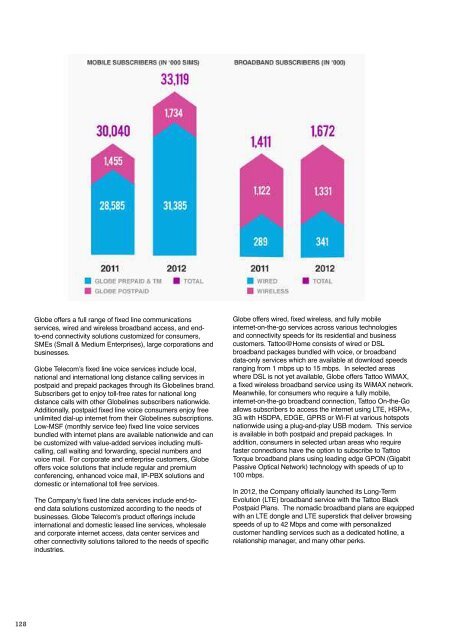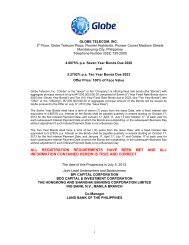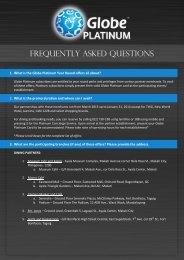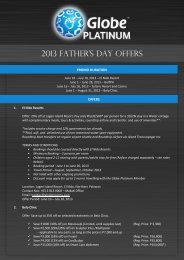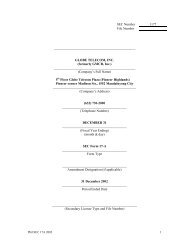here - Ayala
here - Ayala
here - Ayala
You also want an ePaper? Increase the reach of your titles
YUMPU automatically turns print PDFs into web optimized ePapers that Google loves.
Globe 2012 annual report<br />
management discussion and analysis<br />
Globe offers a full range of fixed line communications<br />
services, wired and wireless broadband access, and endto-end<br />
connectivity solutions customized for consumers,<br />
SMEs (Small & Medium Enterprises), large corporations and<br />
businesses.<br />
Globe Telecom’s fixed line voice services include local,<br />
national and international long distance calling services in<br />
postpaid and prepaid packages through its Globelines brand.<br />
Subscribers get to enjoy toll-free rates for national long<br />
distance calls with other Globelines subscribers nationwide.<br />
Additionally, postpaid fixed line voice consumers enjoy free<br />
unlimited dial-up internet from their Globelines subscriptions.<br />
Low-MSF (monthly service fee) fixed line voice services<br />
bundled with internet plans are available nationwide and can<br />
be customized with value-added services including multicalling,<br />
call waiting and forwarding, special numbers and<br />
voice mail. For corporate and enterprise customers, Globe<br />
offers voice solutions that include regular and premium<br />
conferencing, enhanced voice mail, IP-PBX solutions and<br />
domestic or international toll free services.<br />
The Company’s fixed line data services include end-toend<br />
data solutions customized according to the needs of<br />
businesses. Globe Telecom's product offerings include<br />
international and domestic leased line services, wholesale<br />
and corporate internet access, data center services and<br />
other connectivity solutions tailored to the needs of specific<br />
industries.<br />
Globe offers wired, fixed wireless, and fully mobile<br />
internet-on-the-go services across various technologies<br />
and connectivity speeds for its residential and business<br />
customers. Tattoo@Home consists of wired or DSL<br />
broadband packages bundled with voice, or broadband<br />
data-only services which are available at download speeds<br />
ranging from 1 mbps up to 15 mbps. In selected areas<br />
w<strong>here</strong> DSL is not yet available, Globe offers Tattoo WiMAX,<br />
a fixed wireless broadband service using its WiMAX network.<br />
Meanwhile, for consumers who require a fully mobile,<br />
internet-on-the-go broadband connection, Tattoo On-the-Go<br />
allows subscribers to access the internet using LTE, HSPA+,<br />
3G with HSDPA, EDGE, GPRS or Wi-Fi at various hotspots<br />
nationwide using a plug-and-play USB modem. This service<br />
is available in both postpaid and prepaid packages. In<br />
addition, consumers in selected urban areas who require<br />
faster connections have the option to subscribe to Tattoo<br />
Torque broadband plans using leading edge GPON (Gigabit<br />
Passive Optical Network) technology with speeds of up to<br />
100 mbps.<br />
In 2012, the Company officially launched its Long-Term<br />
Evolution (LTE) broadband service with the Tattoo Black<br />
Postpaid Plans. The nomadic broadband plans are equipped<br />
with an LTE dongle and LTE superstick that deliver browsing<br />
speeds of up to 42 Mbps and come with personalized<br />
customer handling services such as a dedicated hotline, a<br />
relationship manager, and many other perks.<br />
The fixed line and broadband business registered significant<br />
gains in 2012, with revenues rising by 9% from ₱14.2 billion<br />
in 2011 to about ₱15.6 billion on account of increasing<br />
demand for data and internet connectivity.<br />
Full year broadband revenues were up 16% to ₱8.7 billion<br />
as the year marked another milestone for the business<br />
with the commercial launch of its broadband LTE service<br />
that provided subscribers with alternative tools to improve<br />
their overall internet experience. The broadband business<br />
likewise continued to ride on the popularity of social<br />
networking sites and benefited from declining prices of<br />
access devices such as PCs, tablets, and laptops. Full year<br />
2012 cumulative broadband subscribers stood at about 1.7<br />
million, up by 18% from 1.4 million in 2011.<br />
The fixed line data also contributed to the Company’s<br />
overall top line growth with revenues of almost ₱4.2 billion,<br />
10% higher than the ₱3.8 billion booked in 2011. This<br />
was accomplished by the Company’s innovative business<br />
solutions and products that capitalized on demand for highspeed<br />
data nodes, transmission links, bandwidth capacity<br />
and reliable service. Globe Business’ products include M2M<br />
(machine-to-machine) solutions, cloud computing services,<br />
domestic and international data services, leased lines and<br />
managed services among other solutions for improving a<br />
business’ productivity and IT security.<br />
On the other hand, subscription to traditional landline service<br />
was slightly revived through low call rate offers and together<br />
with DUO & SUPERDUO’s continued popularity lifted<br />
cumulative voice subscriber base 6% to 711,429 customers.<br />
However, revenues still fell 9% to ₱2.7 million as the strategy<br />
lowered MSF and consequently ARPU.<br />
Financial Performance<br />
Full year 2012 consolidated service revenues soared to a<br />
historic-high of ₱82.7 billion, up 6% from 2011 results of<br />
₱77.8 billion. The mobile business sustained its strong<br />
growth momentum by delivering a 6% year-on-year increase<br />
in revenues on account of the record gross acquisitions in<br />
the postpaid segment, expansion in mobile browsing usage<br />
as well as unlimited and bulk voice services. Incremental<br />
revenues compensated for the decline in IDD revenues<br />
which were partly weighed down by an appreciating Peso,<br />
and also helped to counter market challenges underscored<br />
by peaking penetration levels resulting from increasing<br />
incidence of multi-SIM, declining yields from unlimited and<br />
value promotions, and intensifying competition. Fixed line<br />
and broadband revenues likewise contributed additional<br />
revenues and registered 9% year-on-year growth with<br />
sustained expansion in total broadband subscriber base and<br />
steady demand for data services from the corporate sector.<br />
Operating expenses and subsidy increased by 12% yearon-year<br />
from ₱42.7 billion to ₱47.7 billion as 2012 was a<br />
period of investment in terms of acquiring and retaining<br />
subscribers as well as beefing up capacity with the network<br />
modernization and IT transformation programs. Marketing<br />
and subsidy costs increased substantially following the<br />
aggressive acquisition of new postpaid subscribers who<br />
opted to get the higher-end gadgets such as the Apple<br />
iPhone. Marketing costs also increased to support the<br />
various brand-building initiatives such as product and service<br />
launches for the mobile and broadband business. As a<br />
result, marketing and subsidy as a percentage of service<br />
revenues rose to 13% in 2012 from 9% in 2011. Networkrelated<br />
costs, which included lease, utilities, and repairs<br />
and maintenance, were also higher in 2012 as a result of<br />
the continued expansion of the 2G, 3G, and broadband<br />
networks. Operating expenses in 2012 likewise included<br />
charges for various outsourced and contracted services, as<br />
well as professional fees resulting from the various projects<br />
being undertaken by the Company, including our network<br />
and IT modernization initiatives. Interconnect costs, on the<br />
other hand, were down year-on-year driven by the NTCmandated<br />
reduction in access charges implemented in late<br />
2011.<br />
Consolidated EBITDA of ₱35.0 billion was lower by about<br />
₱93 million from previous year’s total of ₱35.1 billion as<br />
the overall growth in expenses outpaced the increase in<br />
revenues. As a result, EBITDA margin declined from 45% in<br />
2011 to 42% in 2012.<br />
Meanwhile, total depreciation expense grew 25% year-onyear<br />
from ₱18.9 billion to ₱23.6 billion with the increase<br />
attributed mainly to charges related to the network<br />
modernization and IT transformation programs. As the<br />
Company had disclosed in the past, the carrying value of<br />
the old, non-useable assets will impact Globe Telecom’s<br />
profitability through an acceleration of depreciation over<br />
its remaining useful life and until such time when the new,<br />
replacement assets are ready for service. Accelerated<br />
depreciation charges increased further towards the last<br />
quarter of the year to bring full year total to ₱5.1 billion.<br />
Excluding this item, total depreciation expense would have<br />
declined by 2% against previous year to about ₱18.5 billion.<br />
Globe closed the year with core net income of about ₱10.3<br />
billion, up 2% from ₱10.0 billion in 2011. Core net income<br />
excludes foreign exchange and mark-to-market gains<br />
and losses as well as non-recurring items such as the<br />
accelerated depreciation charges related to transformation<br />
initiatives. Reported net income after tax, on the other hand,<br />
was down 30% year-on-year from ₱9.8 billion to ₱6.9 billion<br />
as revenue gains were offset by the impact of accelerated<br />
depreciation charges as well as sustained investments in<br />
subscriber postpaid acquisitions.<br />
128 129


